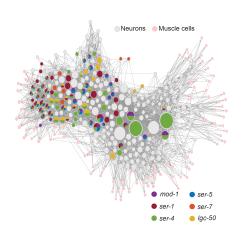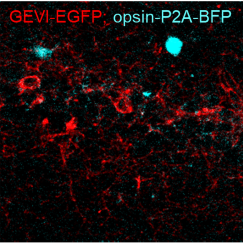Like the beams of light she precisely patterns to probe and control the brain’s electrical activity, Linlin Fan’s research interests have developed a clear focus: advancing technology to make discoveries about how memory works. So where better to launch her career as a primary investigator than The Picower Institute for Learning and Memory and the Department of Brain and Cognitive Sciences at MIT.
“MIT’s neuroscience community has a long history of studying learning and memory,” said Fan, who joins the MIT faculty as an Assistant Professor in January 2024. “But it’s also very interdisciplinary. What attracted me to MIT is not only its neuroscience community but also its engineering school, and chemistry and physics departments that are all close by.”
Fan has combined biology, chemistry, and engineering ever since her undergraduate days on her way to becoming a pioneer of using all-optical techniques to experimentally precisely control and measure neural activity in the brain. As she establishes her new lab at MIT, Fan said she hopes to make an impact both by advancing the technology’s utility for answering a wide variety of neuroscience questions, and by demystifying memory so that diseases such as Alzheimer’s can be better understood.
“By continuing to develop these technologies and disseminating them, I hope that more neuroscientists can benefit from these tools,” Fan said. “And by decoding fundamentally how memory works we hope to understand what goes wrong in disease and ultimately contribute to better treatments.”
A sharpening focus
Fan grew up in central China with a strong interest in science, math and engineering, which ultimately earned her admission to Peking University in Beijing. In an undergraduate research project performed at Stanford, Fan united her interdisciplinary interests to engineer new light-controllable tools to optically control protein activity.
“That’s how it all started, by doing well in school and getting into college, and having the experience of creating something that nature hasn’t created before and feeling the joy of simply finding out the secrets of nature,” she said.
Fan became inspired to apply optical technologies to neuroscience. So when she graduated, she crossed the world to join the Harvard lab of Adam Cohen, a physicist and chemist who was working to develop “genetically encoded voltage indicators.” GEVIs genetically engineer neurons to emit light that instantaneously and precisely indicates the cells’ most subtle changes in membrane voltage. The technology is ideal for genetically targeting specific neurons for fine-grained, long-term monitoring of not just when they “fire” to send electrical signals, but also all the “subthreshold” ebbs and flows of charge that build up to that. But when Fan arrived in Cohen’s lab in 2014, the GEVIs were only useful in single cells in dishes. Fan worked on improving the technologies to measure the communication between neurons (both how they can electrically excite or inhibit each other) and to get them working in awake, behaving animals.
By 2020 she had succeeded. In the journal Cell she demonstrated that she could not only use GEVIs to read out neural electrical activity in live mice, but also simultaneously manipulate neurons with a different color of light using a somewhat more established technology called optogenetics. The experiments revealed how the sense of feeling in mouse whiskers depends on a specific pattern of neural excitation and inhibition in the brain’s outermost layer. Because both optogenetics and GEVIs require shining light onto target cells, and GEVIs then output light, Fan had to devise a way to maximize the signal and minimize any “cross-talk.” Her set up employed distinct light colors and holographic patterning of the separate incoming light sources so they hit just the right parts of the right cells.
For her postdoctoral work Fan moved to the Stanford lab of Professor Karl Deisseroth, a psychiatrist/engineer and pioneer of optogenetics. There Fan hoped to study something that had struck her as more enduring in the brain and more profound for behavior than sensation: memory and knowledge.
At the beginning of 2023, as a capstone on her graduate and postdoctoral work, she published again in Cell, this time applying her all-optical methods to the hippocampus, a brain region central to memory. She showed that by optogenetically stimulating individual CA1 neurons when mice were in a specific place in an environment, she could induce those CA1 cells to become more responsive to those places, as indicated by GEVI measurements. She further developed all-optical interrogation of the connections between those CA1 cells and CA2/3 cells via junctions called “synapses,” and revealed potentiation, or strengthening, of those connections. The study therefore demonstrated the synaptic basis for “behavioral time-scale plasticity,” which is a fundamental transformation for neurons to encode memories, for instance of places.
Launching a lab
“We are only at the beginning of harnessing such technologies to establish direct and causal links between synaptic properties, and neural circuit dynamics, and behavior all in awake, behaving mammals,” Fan said.
In her new Picower Institute lab, Fan wants to expand that capability, for instance by pushing the technology to work in more connected pairs of neurons. She also wants to ensure it can work everywhere in the brain. Helping her get started is a new 2023 Career Award at the Scientific Interface from the Burroughs Wellcome Fund.
The young girl from central China who aspired to a career in science is now a leader at the forefront of all-optical techniques for probing the synaptic and neural basis of learning and memory. Her focus has sharpened, but she has retained all her desire for innovation and discovery.
“Bringing in these new techniques and seeing things no one has seen before is the thrill of innovation and discovery that drives us to continue,” Fan said.



